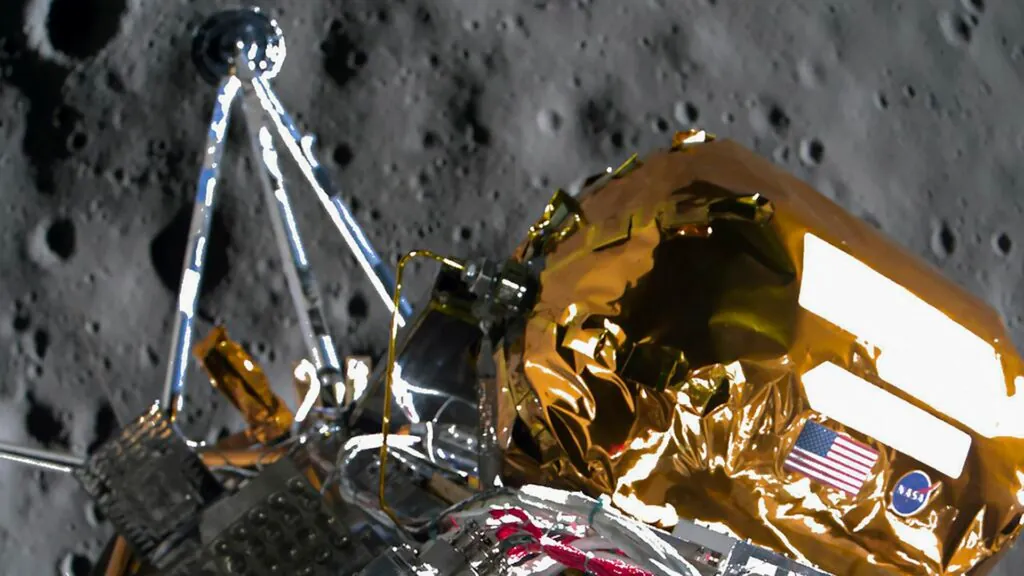In an era where space exploration is reaching new heights, the Odysseus mission stands as a monumental achievement, showcasing human ingenuity and the relentless pursuit of knowledge. Launched by Intuitive Machines, a pioneering force in aerospace technology, Odysseus embarked on its lunar odyssey, setting new benchmarks and expanding our understanding of the moon’s uncharted territories.
A Triumph of Engineering and Science
Odysseus, a marvel of modern engineering, has exceeded all expectations with its performance on the lunar surface. This solar-powered robotic lander, despite facing an unexpected challenge upon landing, has demonstrated unparalleled resilience, collecting invaluable data that promises to enrich our scientific community.
Precision Landing Amidst Adversity
The mission’s climax came during its descent to the moon’s surface, a testament to the precision and robustness of its navigation system. Despite a malfunction in the autonomous landing system’s laser range finder, the team’s swift adaptation and strategic use of backup systems ensured a successful landing. This moment of triumph was not without its trials, as Odysseus encountered the rugged lunar terrain, leading to a gentle tip-over. However, this did not deter its mission; instead, it highlighted the lander’s robust design and the effectiveness of its shock absorbers, safeguarding the integrity of the spacecraft and its payloads.
Unprecedented Scientific Contributions
Odysseus’s journey has been rich with scientific inquiry and discovery. Equipped with payloads from prestigious universities, industry leaders, and NASA itself, the spacecraft has been a conduit for groundbreaking research. From its unique vantage point on the lunar surface, Odysseus has captured images and data that offer fresh insights into the moon’s geology, potentially aiding future manned missions and lunar base constructions.
The Role of Solar Power
The mission’s sustainability and longevity were underpinned by its solar-powered design. As Odysseus’s power reserves dwindle, plans to enter sleep mode and later reawaken the lander underscore the challenges and innovations in power management for lunar exploration. The success of these endeavors hinges on the resilience of the batteries against the moon’s extreme temperatures, a critical aspect for future missions.
The Legacy of Odysseus
Odysseus’s contributions extend beyond its immediate scientific achievements. By being the first American spacecraft to achieve a soft landing on the moon in over five decades, it has reinvigorated lunar exploration, setting the stage for the Artemis program and future endeavors to explore our celestial neighbor.
Educational and Collaborative Milestones
The mission has also been a platform for educational outreach and collaboration. The involvement of students from Embry-Riddle Aeronautical University and the participation of international partners like the International Lunar Observatory Association exemplify the mission’s role in inspiring the next generation of scientists and engineers, fostering a global community united in the pursuit of space exploration.
A Glimpse into the Future
The images and data relayed by Odysseus, including those from the ILO-X telescope, offer a tantalizing glimpse of what the future holds for lunar exploration. These contributions are not just milestones but stepping stones towards humanity’s return to the moon and beyond.
Conclusion
The Odysseus mission, with its blend of innovation, resilience, and scientific inquiry, represents a significant leap forward in our lunar exploration efforts. As we reflect on its journey, we are reminded of the boundless potential of human curiosity and the technological marvels that make such endeavors possible. Odysseus’s legacy is a beacon of inspiration, guiding us towards the next frontier in space exploration. As we stand on the brink of new discoveries, the journey of Odysseus serves as a testament to what we can achieve when we dare to explore the unknown. The data and experiences gleaned from this mission will undoubtedly fuel our quest for knowledge for years to come, proving once again that the sky is not the limit, but just the beginning.
